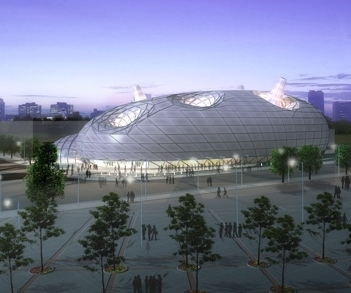Preview
Theme: Harmony of the Hearts, Harmony of the Skills
Highlights: Breathing Organism
National Pavilion Day: 12 June
Location: Within Zone A of the Expo site
展馆主题: 心之和、技之和
展馆亮点:呼吸的生命体
国家馆日:6月12日
展馆位置:A片区
Pavilion Features
The Japan Pavilion is a semi-circular structure, covered by a purple membrane material. Several antennae and caves make the pavilion a "breathing organism," which will express the harmony between the human heart and technology. The pavilion has been dubbed "Purple Silkworm Island" by Chinese people.
 |
| 图为上海世博会日本馆 |
展馆特色
日本馆是一个半圆形建筑,外面罩着一层紫色的薄膜状物质。几处触角和凹穴设计使得整个场馆成为一个“呼吸的生命体”,表达了人类心脏和科技之间的和谐。日本馆被中国人民戏称为“紫蚕岛”。
Pavilion Display
The pavilion uses solar energy collection batteries hidden in the double-layer membrane, and the cave will collect rainwater to spray on its exterior surface to keep temperatures cool. The pavilion is divided into past, present and future exhibits.
展馆外观
日本馆使用的能源来自于隐藏在外部双层膜结构中的太阳能蓄电池,凹穴部分则可以收集雨水并将之喷洒在展馆的外部表面以保持凉爽的温度。整个展馆分为过去、现在和将来三部分展区。
Pavilion Highlights
Highlight 1: Journey through Time
People will experience a journey from ancient times into the future. At the "past zone," the friendship between China and Japan will be highlighted. Historic cases such as a Chinese envoy's visit to Japan in the Tang Dynasty (618-907 AD) and expertise such as Nishijin weaving will be showcased. Japan's modern energy saving and water purification technologies will be exhibited in the "present zone." The exhibition will focus on three topics: water source protection, global warming and the aging problem. The "future zone" will feature a modern opera developed by both Chinese and Japanese directors.
展馆亮点
亮点一:穿越时空之旅
人们将会经历一次从古代到未来的时空之旅。在“过去展区”,中日两国的友谊将是重点展示的内容。唐朝(公元前618年到公元前907年)使节出访日本等历史事件以及西阵织等专业技术也在展示之列。日本的现代节能和水净化技术将会出现在“现在展区”的展示中。这一部分的展示将集中在三个方面:水源保护、全球变暖以及老龄化问题。“未来展区”将上演由中日导演共同执导的一部现代歌剧。
Highlight 2: Opera
The centerpiece of Japan's Expo showcase is an opera about a rare bird that avoided extinction in Japan with the help of China. The crested ibis was declared extinct in Japan in the 1970s. The Chinese government began giving some of its stock to Japan in the 1990s and the birds managed to re-establish themselves in Japan. The opera combines both China's Kunqu opera and Japan's Noh drama to show friendship and exchanges between the two countries.
亮点二:歌剧
日本在世博期间演出的重头戏是一部歌剧,这部歌剧讲的是日中共同拯救一种濒临灭绝的稀有鸟类的故事。朱鹮在20世纪70年代被列为濒危鸟类。中国政府在20世纪90年代开始向日本提供朱鹮种群,使得这一濒危鸟类得以在那里继续繁衍生存。这部歌剧结合了中国的昆曲和日本传统能剧的特点表现了两国的友谊和文化交流。
Highlight 3: Cutting-edge Technologies
Japanese companies will highlight cutting-edge technologies at the pavilion, including a machine that can turn sewage into drinking water, floorboards that can generate electricity when walked on as well as intelligent robots and the country's most advanced vehicles. Several robots will play violins for visitors and a "Life Wall," an electronic wall with virtual televisions, clocks and bookshelves, will be displayed.
亮点三:前沿的科技手段
日本的公司将会在展馆中重点展示他们最前沿的科技成果,其中包括能够把污水转变为饮用水的机器,踩上去就能发电的地板,以及智能机器人和日本最先进的汽车等。届时,将会有几个机器人用小提琴为游客演奏,游客还会看到一面带有虚拟电视机、挂钟和书架的电子墙,这面墙被称为“生命墙”。
(中国日报网英语点津 Helen 编辑)